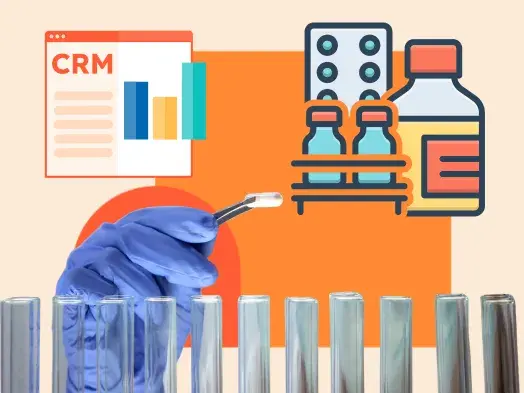Impact of Data Quality On Your Marketing Efforts
While the impact of poor customer data quality is felt throughout your organization, it has an especially volatile impact on your marketing teams.
Everything that a marketing team does — every strategy employed, campaign launched, messaging delivered, & creative produced — is influenced by customer data. Or at least it should be.
That's what great marketing teams do — understand their customers deeply and speak directly to them in a way that resonates. You can't do that if you don't know them, and you can't be sure that you know them if you can't rely on your data.
Let's look at some of the specific ways that data issues and low-quality data can impact your marketing teams.
Segmentation
A big piece of any marketer's job is segmentation. Or, the practice of analyzing long lists of customers and breaking them down into smaller lists so that you can more reliably speak to each segment's concerns.
You wouldn't market your B2B software product in the same way to both CEOs and Marketing Managers, even though both might be targeted buyer personas for your product. They have different needs and concerns. If you try, the language that you use will never fully resonate with both.
So you break things down. You make the list of people that you are speaking to smaller and more manageable. Then, you can use specific language that will resonate with that segment. But if your data isn't reliable, you can't effectively segment it down into those smaller groups.
Marketers cannot properly segment contacts with inconsistent data. With inconsistencies, creating even basic campaigns becomes a complicated analysis effort that requires experts on hand that understand all of the nuances. As a result, it prevents marketers from creating effective campaigns and impedes their ability to execute quickly.
Let's consider an example. Let's say you're a B2B software company, and you want to send out an email campaign to CEOs in your HubSpot CRM.
If you aren't regularly standardizing and formatting your job title field data, you'll find that CEOs are listed in your database in many different ways:
- CEO
- C.E.O.
- Chief Executive Officer
- Founder/CEO
- Founder & CEO
- Owner and CEO
- Etc.
And there are likely to be many other variations as well.
To run a thorough campaign, you need to bring all of these different job titles together, as they are all effectively the same title. To do this, you'll need to either run some creative Excel formulas, create complicated search filters to "catch" all the relevant titles, or enlist the help of a developer. Either way, you are still unlikely to catch every single error in the field.
This doesn't even include typos and other errors in your data, either. Some people might be listed as "CEOn" or have job titles listed that include other data issues. And these standardization and data quality issues can potentially impact your entire database.
For instance, this standardization problem wouldn't only affect CEOs, but every job title in your database. Or, what if you wanted to segment your CRM contacts by city, country, area code, or years of experience? Data issues are present in every field.
Every data point in your database has a host of potential issues that could impact your ability to segment your contacts and deliver effective campaigns that meet your KPI goals.
Data issues make your segmentation efforts complicated and unreliable. Ultimately your marketing teams will be forced to segment less often and less creatively until the issues are rectified.
Personalization
Data issues will also impact your ability to personalize your messaging as well. And personalized messages are critical for successful campaigns.
80% of consumers are more likely to purchase a brand that provides personalized experiences. 72% of consumers say they only engage with personalized messaging.
Your ability to personalize messaging is critical and relies on high-quality, consistent data in your CRM. Have you ever received an email and had your name uncapitalized, or been mistakenly referred to by your last name?
Inherently, you probably know that this is a simple data oversight. They didn't mean to refer to you by your last name. But it does still impact your feelings about the company in question, doesn't it? Maybe it's not intentionally rude, but it's unprofessional to keep your customer data in disarray.
And it's not just about {FirstName} or {JobTitle} either, although those are important. True, deep personalization may not reference the data so directly, but use conclusions drawn from that data to guide your messaging.
For example, one common personalization issue that arises out of CRM data problems comes from associations. In HubSpot CRM, your B2B contacts are associated with companies.
If that association was missing and a portion of your contacts were free-floating, that would make it impossible to execute account-based marketing strategies. Additionally, personalizing the message based on account engagement becomes difficult when you are missing data.
Inconsistent associations also contribute to inaccurate lead scores in account-based marketing. Because scores are applied on the account level, based on variables for the independent contacts within the account, missing contacts will impact the account scores. Ultimately, the difference in lead scoring could affect the lifecycle stage of the entire account, slowing its movement through your pipeline and potentially derailing a deal.
Customer Experience
Issues with segmentation and personalization ultimately impact the experience that customers have during their customer journey. With less specific marketing messaging that is less likely to resonate, their experiences and opinion of your brand will suffer.
92% of marketing professionals see personalization as a "crucial" element of the customer experience. And personalization often relies on your ability to segment customer data effectively to deliver relevant messaging. All of these impacts are interconnected, hurting your entire marketing operation.
Duplicate data, for instance, presents a customer experience issue that can potentially harm your brand reputation. If you don't regularly merge duplicates, many of your customers will receive your messaging multiple times. This drives up the costs of your campaigns, harms your brand reputation, and makes your reporting less reliable.
Deduplication helps achieve a single customer view, which is when your data on your contacts and accounts can all be reliably found in one system. Having one single ‘record of truth' means that your marketing teams can effectively segment and personalize communications. A single customer view provides your teams with faith in your data, allowing them to focus their attention on other areas.
The quality of your data impacts customers every step of the way. Without reliable data, each of those touchpoints is cheapened. Less data, or less reliable data, limits what can be used and what your teams know about each contact. Across months and dozens of touchpoints, that adds up.
The only way for companies to fix these issues is to recognize and embrace data management strategy and regular CRM data maintenance.
What is CRM data maintenance?
CRM data maintenance is the ongoing process of auditing your CRM data, identifying issues, and fixing those issues within your database.
The larger process of maintaining your CRM data can be broken down into numerous focus areas, including:
- Data Quality
- Data Cleansing
- Data Operations
- Data Deduplication
- Data Purging
- Data Monitoring and KPIs
Data Quality
Data quality refers to data that is accessible, consistent, and relevant. Your entire organization is impacted by the quality of your data — from individual campaigns through larger strategic decisions.
Accessible means not only that the data is accurate, but that the right people within your organization can access it when they need it. Siloed data creates bureaucratic redundancies that slow your organization down.
Data consistency largely refers to how consistently data is formatted and standardized in your database. Are your phone numbers formatted uniformly? Are your job titles standardized? Are your contact names appropriately capitalized? Consistency allows you to slice and dice data in interesting ways.
Then there is relevance. It doesn't matter if you have a million perfectly accurate records in your CRM if none of them are in your target market. The data that you collect must be relevant to be useful.
Data quality is achieved through other data maintenance processes like data cleansing.
Data Cleansing
Data cleansing is the process of fixing or removing incorrect, improperly formatted, duplicate, or incomplete data within your CRM.
- Fixing first and last name capitalization issues (jane vs. Jane)
- Standardizing addresses and phone numbers (1234567890 vs 123-456-7890)
- Standardizing Job titles (CEO vs. C.E.O vs. Chief Executive Officer)
- Removing redundant data
- Removing incorrect and fake data
- Removing special characters
- Identifying and fixing outlying issues
The process of cleansing data can be time-consuming. Often it involves breaking out chunks of your database and assigning fixes and tasks to members of your team. Then, they will load the data into Excel and use VLOOKUP and complicated formulas to identify and fix errors in your data. Once complete, the data has to be reimported back into your CRM.
It's a non-exact process. Unless you have a true Excel wizard on your team, you're likely to miss many issues and still require ongoing help from developers to update data in bulk.
Data Deduplication
All companies deal with duplicate data. Duplicate contact or company records might be created through manual entry, either by your customers into forms or by your team through your backend CRM. Or, they may be created through data imports or integrations with other software.
No matter how duplicate records are created, they can be a thorn in the side of your marketing team.
Duplicate data leads to increased campaign costs and lost productivity. As your teams spend time ironing out data issues instead of focusing on other areas, leading to missed opportunities. Every second they spend sifting through records to identify the "correct" or most complete record is wasted time. Duplicate data shatters your single customer view, as there is no single ‘source of truth' that can be relied on.
When you have high duplication rates, your marketing teams will always be aware of that fact. They know that they will have to deduplicate any list of prospects or customers before new campaigns go out, adding a new task to every campaign launch.
Most critically, duplicate data harms the customer experience. Not just because they are likely to receive mixed messages and redundant messaging. But because your ability to understand them will be halved throughout the customer lifecycle, leading to less fulfilling interactions over and over again.
Data Operations
Data operations encompasses the ongoing day-to-day tasks that are required to maintain your CRM data and ensure the usability of that data across your organization.
Data operations tasks include day-to-day bulk updating of data, consolidating fields and redundant data, migrating free-text fields to picklists, importing data (from events or third-party sources), and other tasks.
These tasks are a necessity for high-quality data, and for putting your data in a position where data cleansing can be as effective as possible.
Data Purging
Data purging encompasses the removal of garbage data, outdated data, redundant data, and low-quality data that will only serve to clutter up your database and negatively impact your reputation and email open rates.
There are many types of data issues that could potentially make records a good candidate for purging. Examples include:
- Undelivered emails
- Clearly fake data
- Outdated records
- Unqualified prospects
- Bad records from integrations
- Incomplete Contact Data
- Free and role-based email addresses
- Unengaged contacts
- Unqualified contacts
- Duplicate contacts
Purging this data is critical for improving the usability of your CRM data as a whole. Without having to continually sift through and remove garbage data for campaigns, your productivity will improve.
Without clutter, you'll be able to keep costs down on data storage and contact-based CRM fees, along with the time that your teams would usually spend dealing with the purged records.
Without low-quality data dragging down your email delivery and open rates, you'll avoid being penalized and enjoy an improved sender reputation.
Data Monitoring and KPIs
To fix issues in your CRM database, you'll need to be able to identify where those issues lie. Between the different data issues that you'll find in your database, understanding what those issues are and what kind of issues there are helps you to prioritize fixing the most impactful problems.
Of course, you could monitor your KPIs and generate reports manually. But that involves running reports or exporting data to Excel and analyzing it. However, some tools can automate diagnostics and collections KPIs.
For example, the CRM Data Grader is a tool that connects directly to HubSpot, analyzes the CRM database, and surfaces specific issues that you need to fix. This ensures you have visibility into the quality of your data and actionable insights for dealing with those issues.
Having a clear key performance indicator, such as the percentage of clean records in your database, allows you to track your progress and quickly assess the overall health of your customer data.
Differences Data Maintenance and Standard Cleanup Projects
Standard data cleanup projects are short-term and tactical. You find a fire, you put it out. Data cleanup projects are reactive because they have to be. Sometimes unexpected data issues can grind things to a halt and need to be fixed immediately. Those needs will always be there, but less often with a data maintenance strategy.
Unlike one-off cleanup projects, data maintenance is an ongoing strategy. It requires consistent investment and attention, but with the help of modern data management tools you can automate a majority of your data maintenance tasks, improving operations across your teams.
As your customer data grows, management of that data becomes more complicated. It requires more focus and planning to ensure your data is accessible, consistent, and relevant.
As this happens, companies tend to move through several stages on their way toward true data maintenance optimization:
- Undefined and chaotic. No understanding of issues and no processes in place to deal with them.
- Visibility. Aware of data-related problems have visibility into the specific problems in their database, with reporting generated automatically regularly.
- Standardization. Established data quality standards and alignment among cross-functional teams about data expectations and goals. To execute effectively, standards need to be enforced automatically.
- Optimization. Employ automation to proactively cleanse and maintain data, avoid repetitive manual work, streamline data corrections and collaboration, alert about exceptions.

Data maintenance isn't something that you do once and then never again. This process is something that you'll need to do over and over again. You need accurate documentation and processes in place to minimize your time investment.
New data is always flowing into your CRM database, and with that data will come a range of issues and errors that have the potential to slow down nearly every team in your organization. Tools like Insycle help you to audit your existing data, identify common data issues, and fix them on an automated set schedule.
Improving your CRM data maintenance processes enable your marketing teams to produce more marketing qualified leads through improved segmentation, personalization, and nurturing.
Quality data means that you can represent your brand professionally in all communications with customers while improving their experience throughout the customer lifecycle.




%20(1).png)






.png)
.png)
